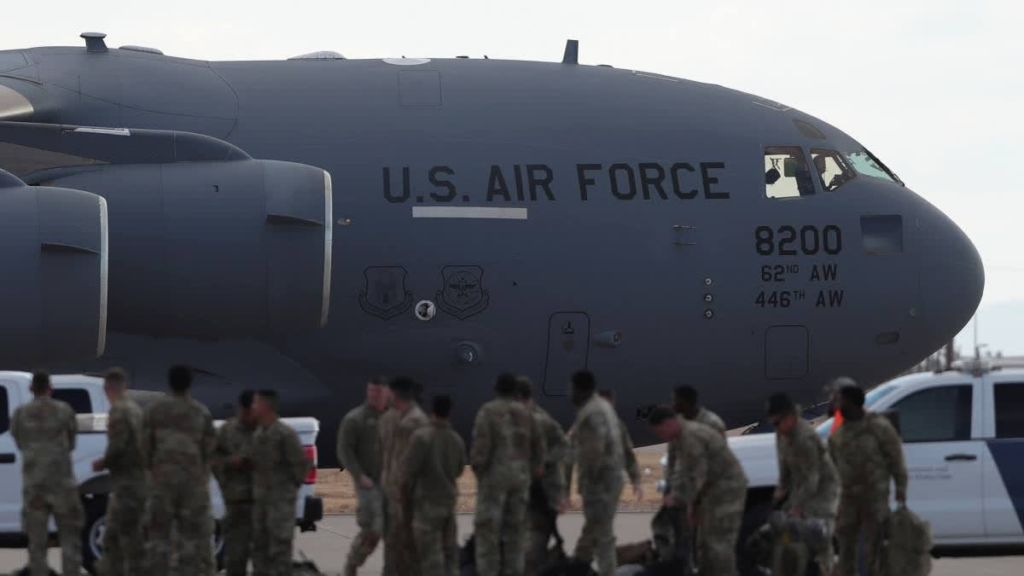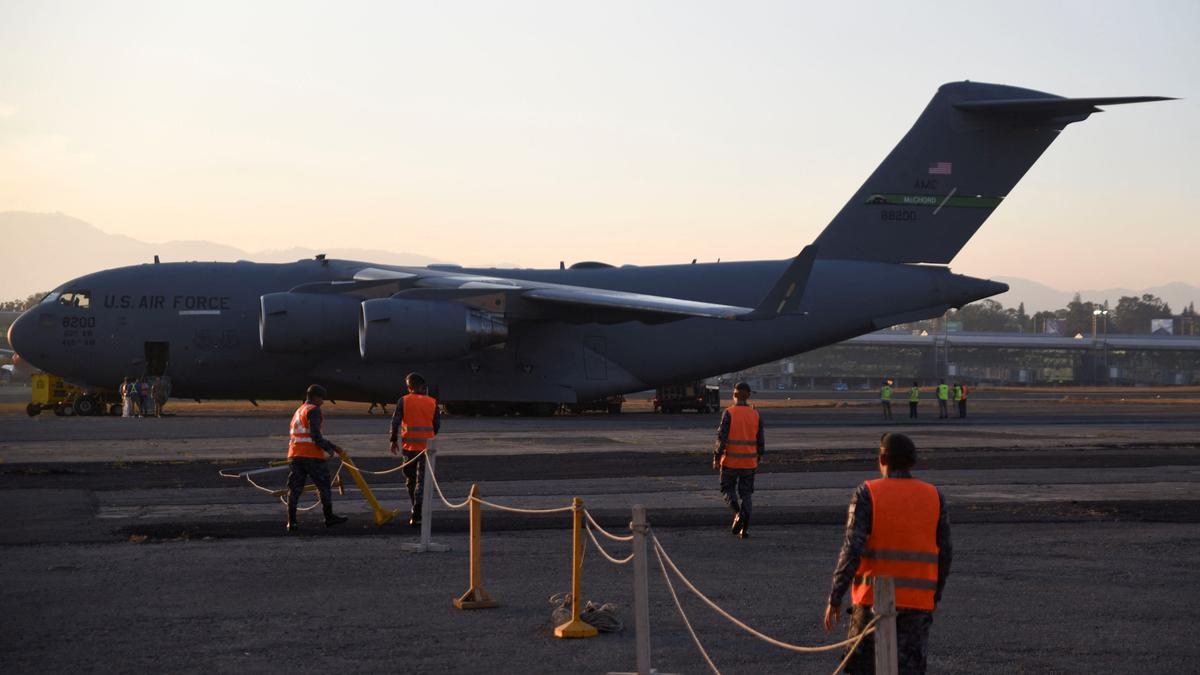In a significant development amid the ongoing debate over immigration policies, the United States has commenced the deportation of Indian migrants under the administration of President Donald Trump.
The U.S. military’s C-17 aircraft, carrying 205 Indian nationals, departed from San Antonio, Texas, marking a new chapter in the government’s hardline approach toward undocumented immigration.
The move comes as part of the broader crackdown on the estimated 11 million undocumented migrants living in the United States. As this situation continues to unfold, it sheds light on the complexities surrounding international migration and the U.S.’s approach to addressing immigration challenges.
The Departure of 205 Indian Migrants
The C-17 aircraft, known for its ability to carry large loads over long distances, embarked on its journey early in the morning at around 3 am IST from San Antonio, Texas.
Onboard were 205 Indian migrants, all of whom were verified by the Indian government before being placed on the military plane. These individuals were among the thousands of undocumented migrants from India who have faced deportation due to their status in the U.S. under Trump’s stricter immigration policies.
The aircraft’s journey to India represents the furthest destination for U.S. military deportation flights, given that the majority of previous flights have transported migrants to Latin American countries, including Guatemala, Honduras, and Peru.
The Pentagon confirmed that flights carrying migrants from U.S. cities like El Paso, Texas, and San Diego, California, have been scheduled to depart for these countries, with plans for further deportations in the coming months.
Read : EL Salvador to Accept Deportees of Any Nationality: Rubio
Indian nationals have been increasingly identified as part of the migrant groups facing deportation. This is especially notable considering that India represents the largest proportion of skilled workers entering the U.S. on H-1B visas.
Read : What is Xenophobia and How It’s Stalling the Economy of India, China, and Japan
According to reports, the U.S. and Indian governments have been working together to identify approximately 18,000 undocumented Indian migrants in the U.S. These individuals have been caught in the crossfire of the political clash over immigration policy, with both countries seeking to balance their interests.
Trump’s Hardline Stance on Immigration
This deportation marks the latest effort under President Trump’s immigration agenda, which has included various measures aimed at curbing the number of undocumented migrants entering and residing in the U.S. From his first day in office, Trump vowed to tackle the issue of illegal immigration and sought aggressive measures to ensure that migrants without proper authorization were sent back to their home countries.
As part of his broader strategy, Trump declared a national emergency at the southern border, which led to the imposition of various border control measures, including the deployment of military resources to assist in enforcing immigration laws.
The recent use of military aircraft to deport migrants is a clear manifestation of Trump’s resolve to use the U.S. military in enforcing his immigration policies.

The president has long advocated for tougher border security and immigration control, often framing the issue as a matter of national security. The launch of military deportation flights is part of his emergency declaration, and it highlights the administration’s willingness to take bold steps to address immigration concerns.
This hardline approach to immigration has been a source of contention, both within the U.S. and internationally. Critics argue that the use of military planes for deportations is not only costlier than other alternatives but also raises concerns about the treatment of migrants during the deportation process.
Reports have indicated that the cost of a military deportation flight to Guatemala, for example, is significantly higher than that of a commercial flight. While the U.S. government asserts that these actions are necessary for national security, the financial and human implications are drawing increasing attention.
Diplomatic Tensions and International Cooperation
The deportation of Indian migrants is not occurring in isolation but within a larger context of international cooperation and diplomacy. Following President Trump’s tough rhetoric on immigration, the U.S. government reached out to various countries, including India, to manage the return of migrants.
A call between Trump and Indian Prime Minister Narendra Modi highlighted the need for India to take back its citizens who were found to be residing illegally in the U.S. During the call, Trump conveyed his expectations that India would cooperate in ensuring that these individuals were returned home.
The U.S. government has identified a substantial number of undocumented Indian migrants in the country, and both governments have recognized the need for a coordinated effort to address the issue. The fact that military aircraft are being used to deport Indian nationals underscores the seriousness with which the U.S. is pursuing this policy.

India’s role in accepting deported citizens has been significant. The country has a large diaspora in the U.S., and many of the migrants being deported are skilled workers, students, and professionals who originally came to the U.S. on work or student visas.
While India has expressed a commitment to facilitating the return of its nationals, there are concerns about the impact of these deportations on the individuals involved and on U.S.-India relations. As more migrants are sent back to India, both governments will have to navigate the complexities of international migration and human rights.
Challenges and Costs of Deportation Flights
The cost of deportation flights, particularly those conducted by military aircraft, has raised concerns regarding the efficiency and financial impact of these operations. Reports suggest that the cost of flying a migrant back to their home country on a military plane can be significantly higher than using commercial airlines or chartered flights.
A military flight to Guatemala, for example, could cost upwards of $4,675 per migrant, a figure that dwarfs the cost of a commercial first-class ticket. The higher costs of military deportation flights have led to questions about whether the U.S. government is spending taxpayer money efficiently.
The argument against military deportation flights is that commercial flights or chartered flights operated by agencies like U.S. Immigration and Customs Enforcement (ICE) could accomplish the same objective at a fraction of the cost. Furthermore, critics argue that using military resources for this purpose could be seen as a wasteful expenditure, especially considering the limited number of deportation flights available.
While the cost of deportations is a point of debate, the broader implications of Trump’s immigration policies are being felt not only by migrants but also by the American public.

The rhetoric surrounding immigration has been highly polarizing, and the U.S. government’s approach has faced both support and backlash from various sectors of society. As the number of deportations increases, there will likely be continued debate over the financial and social costs of enforcing such policies.
U.S. Immigration Policy in the Trump Era
As the U.S. continues its military deportation flights and steps up its border enforcement efforts, the future of immigration policy under the Trump administration remains uncertain.
Trump’s promises to deport millions of undocumented migrants have yet to fully materialize, but the current wave of deportations is indicative of the administration’s continued commitment to reducing illegal immigration.
The outcome of these policies will likely shape the political landscape for years to come, influencing not only the lives of migrants but also the broader debate over immigration reform in the U.S. President Trump’s use of military resources in deportation efforts signals his willingness to take unconventional measures to achieve his goals. However, it also raises questions about the broader ethical and practical implications of such actions.
The deportation of 205 Indian nationals is just one chapter in the larger narrative of immigration reform in the U.S. As the situation continues to evolve, the international community will be watching closely, particularly as countries like India respond to the growing number of their nationals being sent back from the U.S.
The road ahead for U.S. immigration policy remains contentious, with both supporters and critics of Trump’s approach seeking to shape the future of American immigration law.

